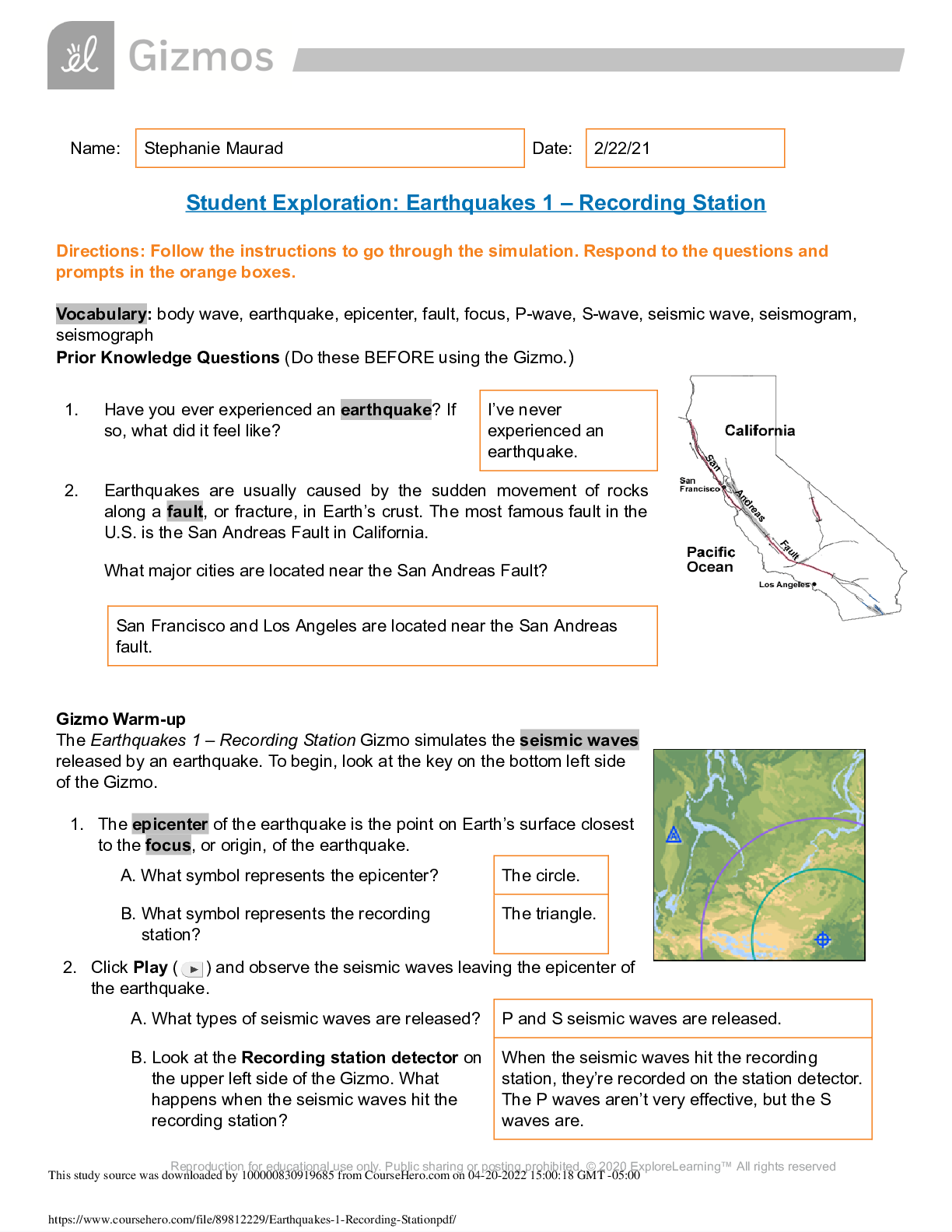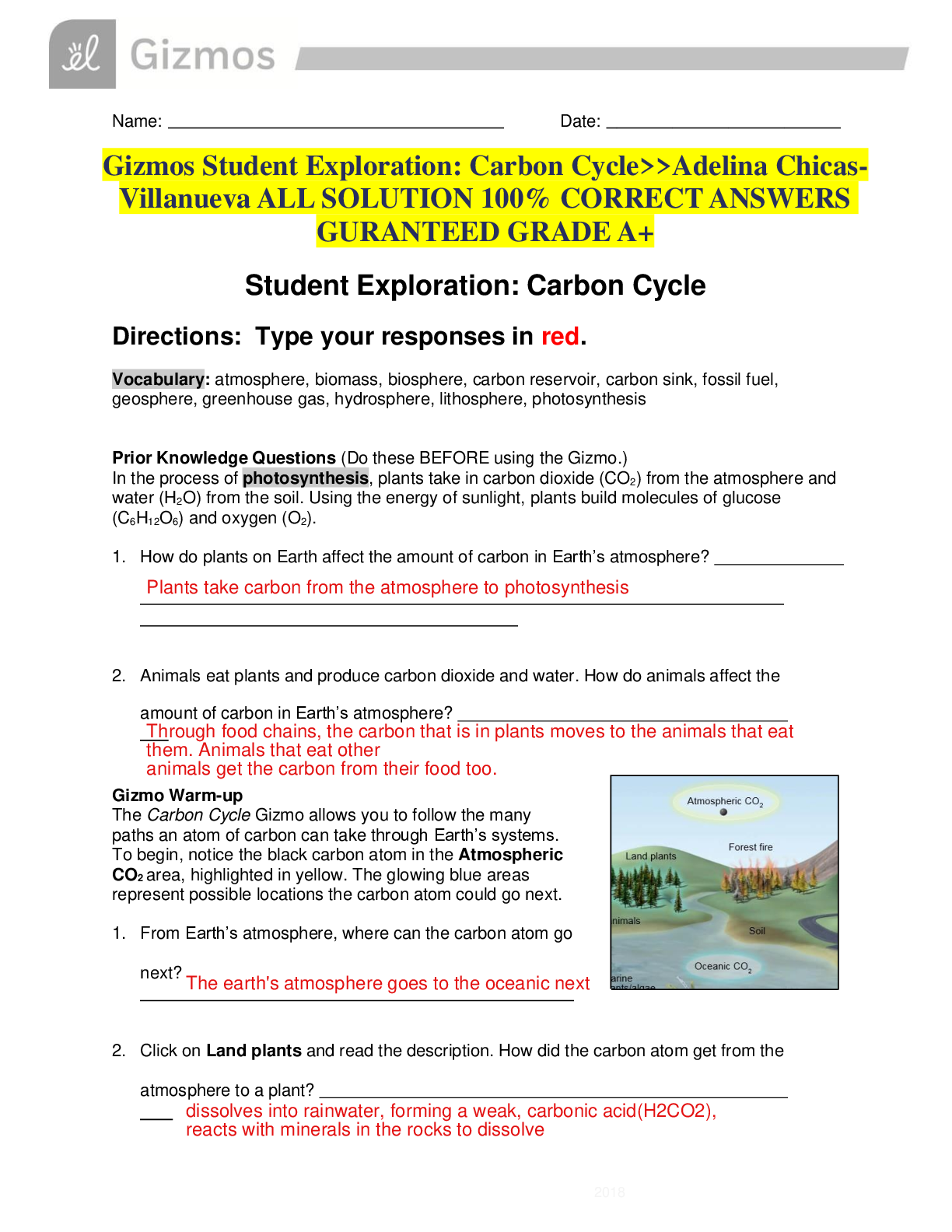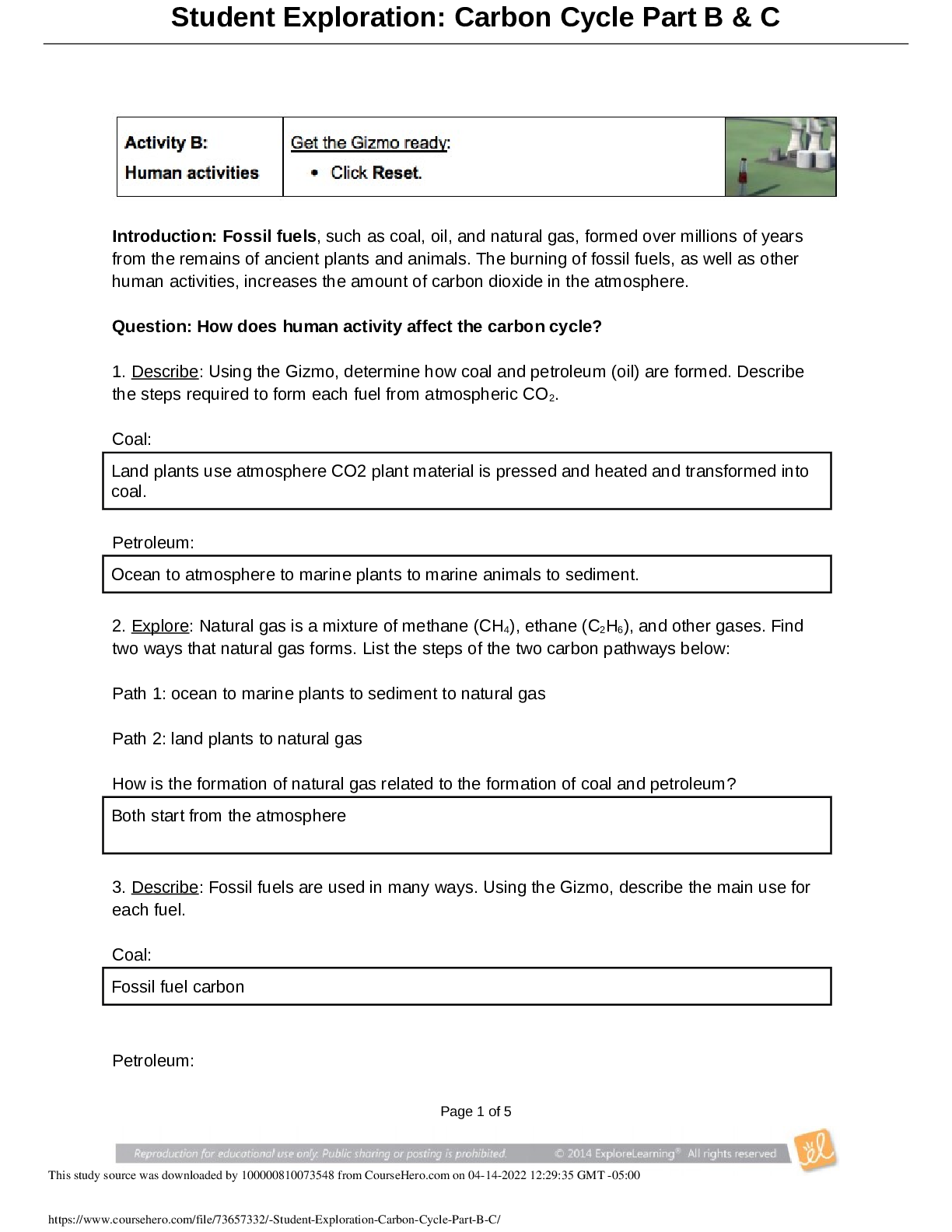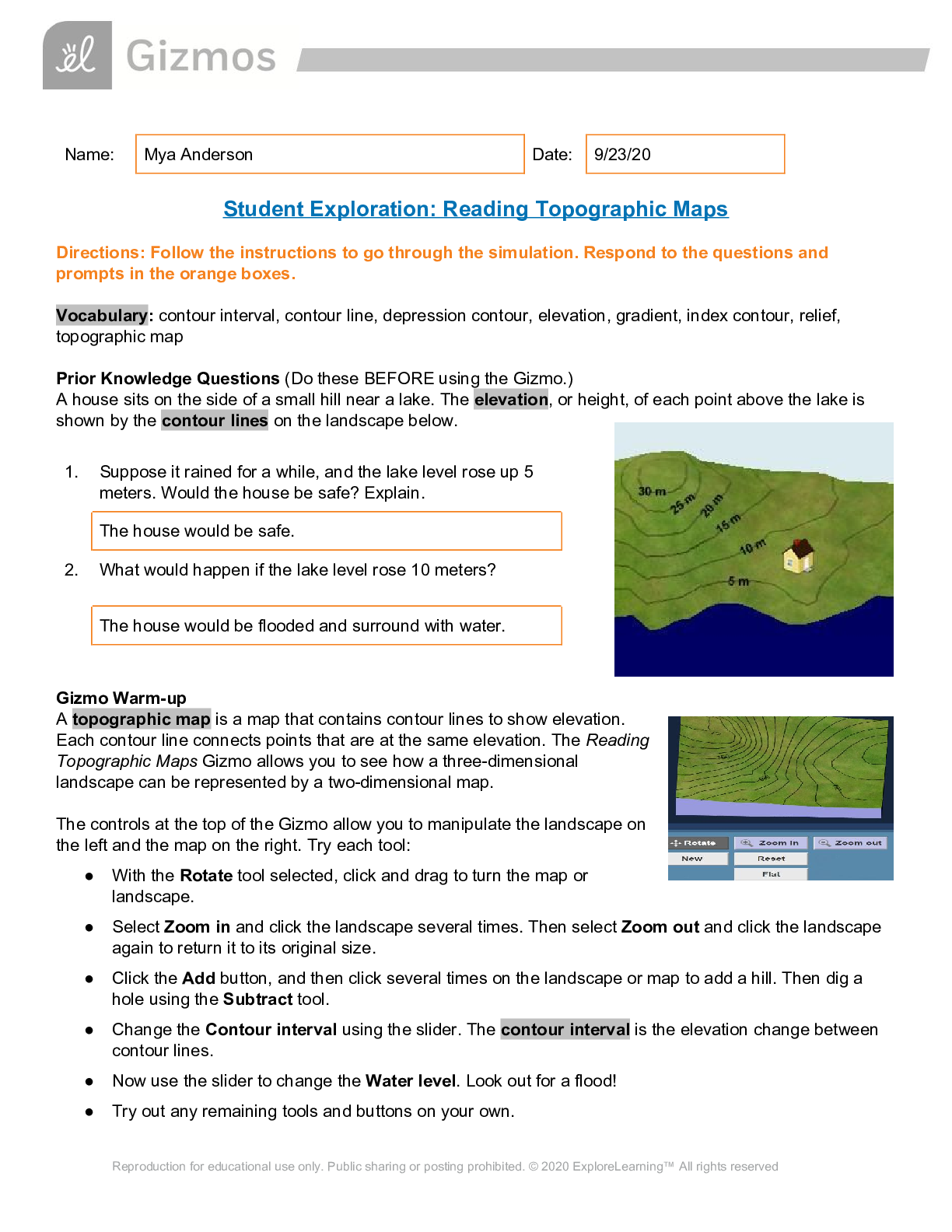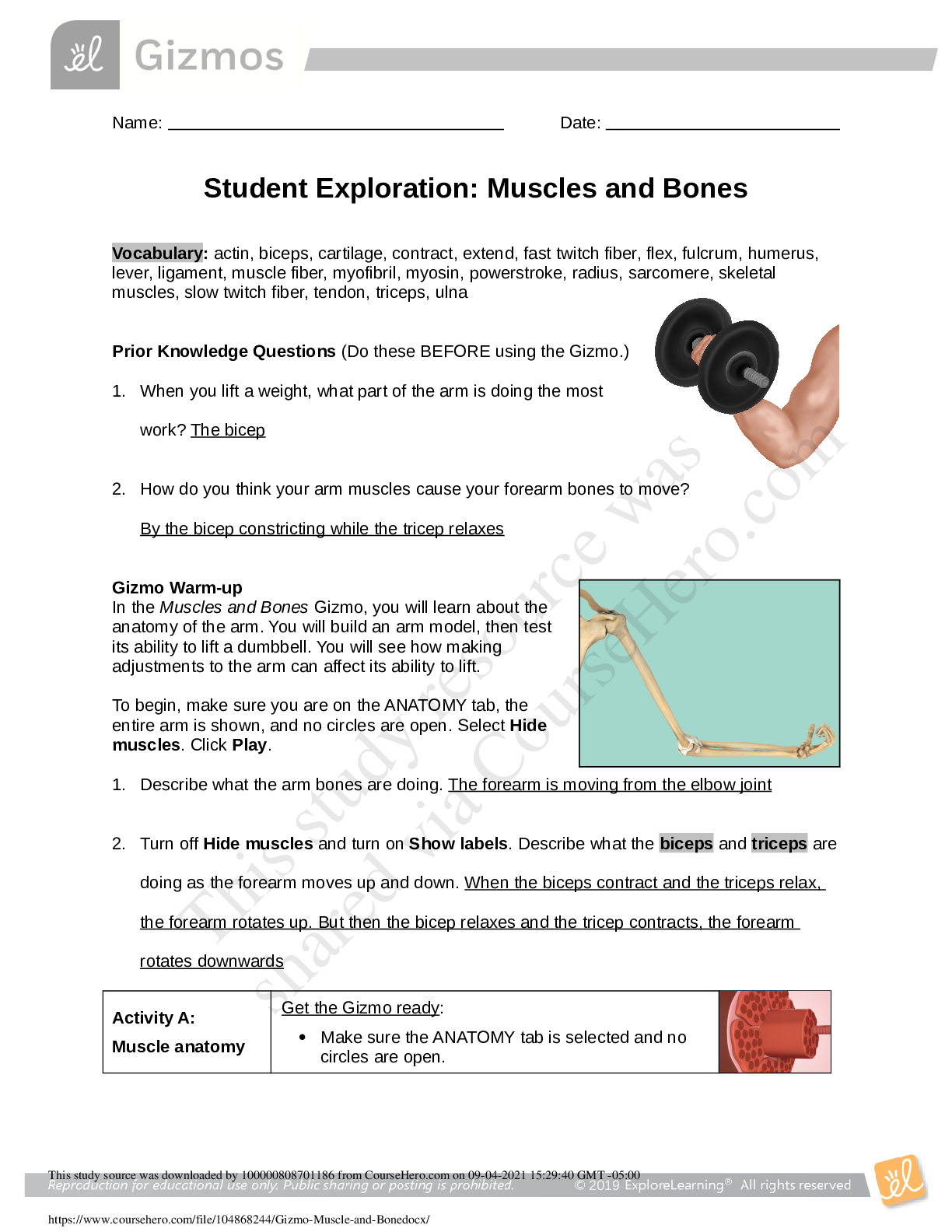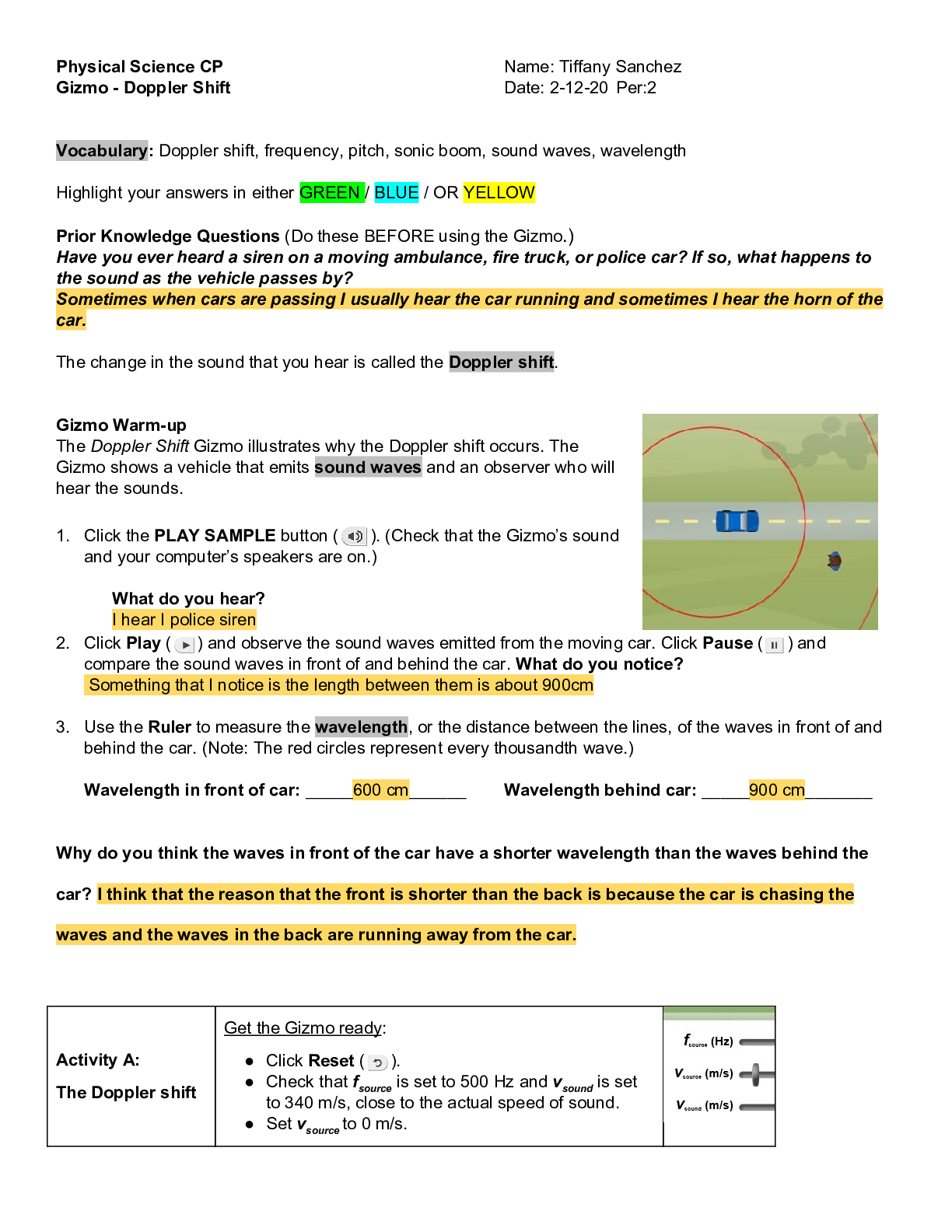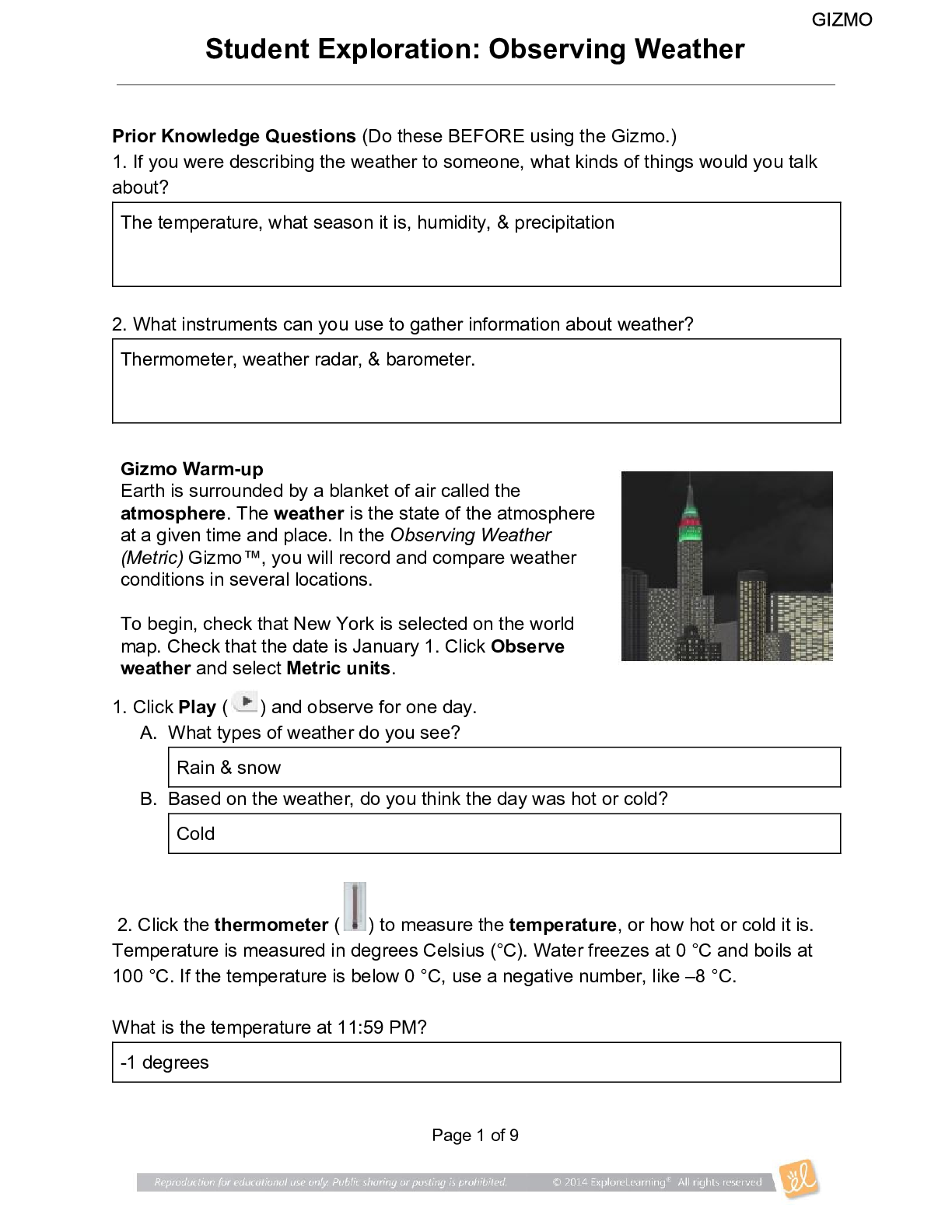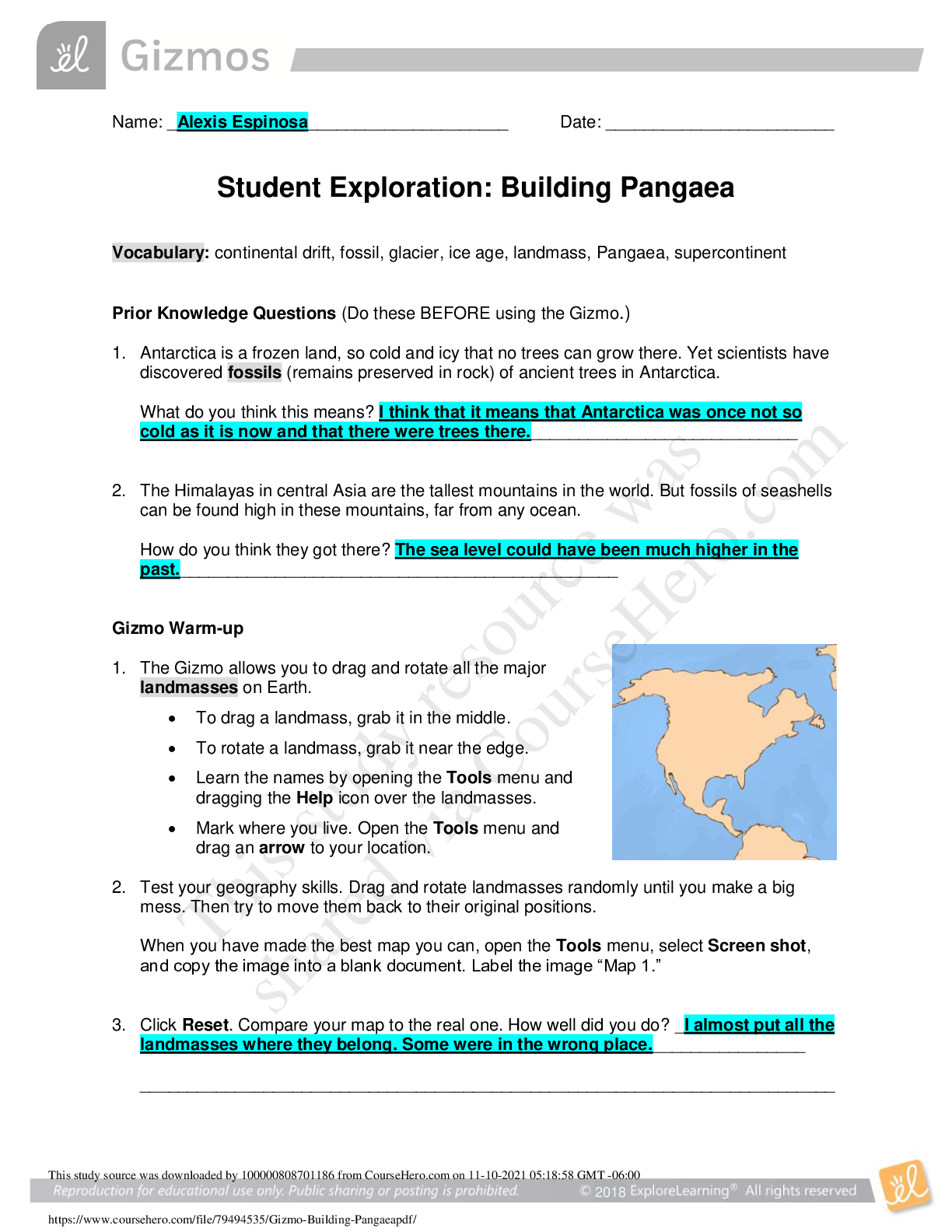GIZMOS. Student Exploration: Waves. MATH 101 Waves.
Document Content and Description Below
Student Exploration: Waves Vocabulary: amplitude, compression, crest, frequency, longitudinal wave, medium, period, power, rarefaction, transverse wave, trough, wave, wavelength, wave speed Prior K ... nowledge Questions (Do these BEFORE using the Gizmo.) 1. A buoy is anchored to the ocean floor. A large wave approaches the buoy. How will the buoy move as the wave goes by? The buoy will move because the wave will push it. 2. The two images show side views of ocean waves. How are the two sets of waves different? The two images showing the two different sides of the ocean waves are different because the first image of the wave is higher than the second image of the ocean wave. Gizmo Warm-up Ocean swells are an example of waves. In the Waves Gizmo™, you will observe wave motion on a model of a spring. The hand can move the spring up and down or back and forth. To begin, check that the Type of wave is Transverse, Amplitude is 20.0 cm, Frequency is 0.75 Hz, Tension is 3.0 N, and Density is 1.0 kg/m. Click Play ( ). 1. How would you describe the motion of a transverse wave? In my opinion, I think that the motion of this transverse wave is moving at right angles. Because, the speed stays the same and the wave power doesn’t change either. Click Pause ( ). Notice the crests (high points) and troughs (low points) of the wave. 2. Click Reset ( ). For the Type of wave, choose Longitudinal. Increase the Amplitude to 20.0 cm, and click Play. How would you describe the motion of a longitudinal wave? I think, that the motion of this longitudinal wave is a wave that is going said to side but in a slow speed. Click Pause. Notice the compressions in the wave where the coils of the spring model are close together and the rarefactions where the coils are spread apart. This study source was downloaded by 100000810822090 from CourseHero.com on 03-26-2021 19:49:16 GMT -05:00 Activity A: Measuring waves Get the Gizmo ready: Click Reset. Select Transverse waves. Set Amplitude to 20.0 cm, Frequency to 1.0 Hz, Tension to 2.0 N, and Density to 2.0 kg/m. Question: How do we measure and describe waves? 1. Observe: Click Play. Observe the motions of the hand and of the green dot in the middle. A. What is the motion of the hand? The motion of the hand is increasing and decreasing. B. Turn off the Lights on checkbox and observe the green dot. What is the motion of the green dot? The motion of the green dot is also decreasing and increasing. C. Follow the motion of a single crest of the wave. How does the crest move? The crest moves to the right because of the hand’s motion. In a transverse wave, the motion of the medium (what the wave moves through—in this case, the spring) is perpendicular to the direction of the wave. So, each point of the spring moves up and down as the wave travels from left to right. 2. Measure: With the lights on, click Pause. Turn on Show rulers. A. Use the horizontal ruler to measure the horizontal distance between two crests. What is this distance? 100 cm this is the wavelength of the wave. B. What is the distance between the two troughs? 110 cm The wavelength can be found by measuring the distance between two successive crests, two successive troughs, or any two equivalent points on the wave. C. Click Reset. Set the Density to 1.0 kg/m. Click Play, and then Pause. What is the wavelength of this wave? 140 cm 3. Measure: Click Reset. The amplitude of a transverse wave is the maximum distance a point on the wave is displaced, or moved, from its resting position. Turn off the lights. Click Play, and then click Pause. Use the vertical ruler to measure the height of the green trace, showing how far the green dot moved up and down. A. What is the height of the green trace? 40 cm B. The wave’s amplitude is equal to half of this height. What is the amplitude? 20 cm (Activity A continued on next page) This study resource was shared via CourseHero.com Activity A (continued from previous page) 4. Observe: Click Reset. Select Lights on and turn off Show rulers. Select Longitudinal waves. Check that the Amplitude is 10.0 cm, the Frequency is 1.00 Hz, and the Tension is 2.0 N. Set the Density to 1.0 kg/m, and click Play. A. What is the motion of the hand? The motion of the hand is pulling and pushing. B. Turn the lights off. What is the motion of the green dot? The motion of the green dot is going left to right. C. Follow the motion of a single compression of the wave. How does the compression move? The compression of this wave is pulling and pushing the water forward and towards. In a longitudinal wave, the motion of the medium is parallel to the direction of the wave. So, each point of the spring moves back and forth as the wave is transmitted from left to right. 5. Measure: With the lights on, click Pause. Turn on Show rulers. A. The wavelength of a longitudinal wave is equal to the distance between two successive compressions (or rarefactions). What is this distance? 160 cm B. How does this compare to the wavelength of the comparable transverse wave? (See your answer to question 2C.) That we are only measuring one wavelength. 6. Measure: Click Reset. The amplitude of a longitudinal wave is equal to the distance a point on the wave is displaced from its resting position. Turn off the lights. Click Play, and then click Pause. Use the horizontal ruler to measure the width of the green trace. A. What is the width of the green trace? 20 cm B. The amplitude is equal to half of this distance. What is the amplitude? 10 cm 7. Calculate: Click Reset. Select Transverse waves. Select Lights on and Show grid and turn off Show rulers. Set the Frequency to 0.50 Hz. A single cycle is the time it takes the hand to move up, move down, and then back up to the starting position. Click Play, and then click Pause after exactly one cycle. (This may take a few tries.) A. How long does one cycle take? 2.60 seconds this is the period (T) of the wave. This study source was downloaded by 100000810822090 from CourseHero.com on 03-26-2021 19:49:16 GMT -05:00 B. Frequency (f) is equal to 1 divided by the period: f = 1T . Frequency is measured in hertz (Hz), where 1 Hz = 1 cycle/sec. What is the frequency of this wave? 5/13 or 0.4 This study source was downloaded by 100000810822090 from CourseHero.com on 03-26-2021 19:49:16 GMT -05:00 Activity B: Wave dynamics Get the Gizmo ready: Click Reset. Check that Transverse is selected. Set Amplitude to 20.0 cm, Frequency to 0.75 Hz, Tension to 3.0 N, and Density to 1.0 kg/m. Question: What factors affect the wavelength, speed, and power of waves? 1. Record: The speed of a wave is the distance a wave pulse travels per second. The wave speed is displayed below the spring. Click Play. What is the wave speed? 173.2 cm/s 2. Experiment: The wavelength and speed of a wave can be influenced by many factors. Adjust the amplitude, frequency, tension, and density as described in the table below. Then report whether this causes the wavelength and wave speed to increase or decrease. Return each variable to its original value after each experiment. Adjustment Effect on wavelength Effect on wave speed Increase amplitude Increase Increase Increase frequency Decrease Increase Increase tension Increase Increase Increase density Increase Increase 3. Analyze: Click Reset. Set the Frequency to 0.80 Hz, Tension to 2.0 N, and Density to 2.0 kg/m. Click Play, and then click Pause. Turn on Show rulers. A. What is the wavelength? 80 cm B. What is the wave speed? 100.0 cm/s C. How are the wavelength, frequency, and wave speed related? If the wave speed is lower or higher that’s how the wavelength relates. In general, the wave speed (v) can be calculated from the frequency (f) and wavelength (λ) using the formula v = f • λ. D. What is the wavelength of a wave with f = 0.9 Hz and v = 154.9 cm/s? 172.1 cm To check, set Frequency to 0.90 Hz, Tension to 2.4 N, and Density to 1.0 kg/m. E. Change the Density to 1.5 kg/m, and click Play. Based on the wave speed, what do you expect the wavelength to be? Lower Measure the wavelength to check. (Activity B continued on next page) This study source was downloaded by 100000810822090 from CourseHero.com on 03-26-2021 19:49:16 GMT -05:00 Activity B (continued from previous page) 4. Gather data: Click Reset, and turn off Show rulers. The power of a wave is the amount of energy it transmits each second. The power of the wave is displayed below the spring when Play is pressed. Record the wave power for each of the settings below. Amplitude Frequency Tension Density Power 20.0 cm 0.60 Hz 2.0 N 1.0 kg/m 0.402 W 40.0 cm 0.60 Hz 2.0 N 1.0 kg/m 1.61 W 20.0 cm 0.50 Hz 2.0 N 1.0 kg/m 1.12 W 20.0 cm 1.00 Hz 2.0 N 1.0 kg/m 1.12 W 20.0 cm 0.60 Hz 2.0 N 1.0 kg/m 0.402 W 20.0 cm 0.60 Hz 4.0 N 1.0 kg/m 0.568 W 20.0 cm 0.60 Hz 2.0 N 0.5 kg/m 0.284 W 20.0 cm 0.60 Hz 2.0 N 1.0 kg/m 0.127 W Which factors increased the power of the wave? The tension and the density. 5. Compare: Click Reset. Select Longitudinal waves. Set Amplitude to 20.0 cm, Frequency to 0.60 Hz, Tension to 2.0 N, and Density to 1.0 kg/m. Click Play. A. What is the power of this longitudinal wave? 0.402 W B. Compare this power to the power of a transverse wave with the same settings. Does changing the type of wave affect its power? NO 6. Apply: Sound waves are longitudinal waves that can travel through air. Would you expect sound waves to travel faster through a low-density gas (such as helium) or a higher-density gas such as carbon dioxide? Justify your answer based on what you have learned. In my opinion, if the density is lower the wave will be lower too. But if the wave is higher the wave will be higher too. 7. Apply: As ocean waves approach the shore, friction with the ocean bottom causes them to slow down. If the frequency is the same, how will this affect the wavelength of the waves? If the frequency is higher the wave power will be very higher too. This study source was downloaded by 100000810822090 from CourseHero.com on 03-26-2021 19:49:16 GMT -05:00 Activity C: Combined waves Get the Gizmo ready: Click Reset. Select Combined waves. Set Amplitude to 10.0 cm, Frequency to 0.75 Hz, Tension to 2.0 N, and Density to 1.0 kg/m. Question: What does wave motion look like when transverse and longitudinal waves are combined? 1. Observe: Click Play. Observe the motions of the hand and of the green dot in the middle. A. What is the motion of the hand? The hand is going in a circular motion. B. Deselect the Lights on checkbox. What is the motion of the green dot? The motion of the green dot is also circular motion. In a combined wave, the motion of the medium is circular. So, each point of the spring moves in a circle as the wave is transmitted from left to right. C. Click Pause. Compare the crests (high points) to the troughs (low points). What do you notice? That the wavelength is higher but the height of the wave is lower. Combined waves, such as ocean waves, do not look exactly like transverse waves. In the Gizmo, the troughs are pointy and the crests are rounded. In the ocean, the crests are relatively pointy while the troughs are rounded. 2. Measure: Click Reset. Select Lights on and Show rulers. Set the Frequency to 1.0 Hz. Check that the Tension is 2.0 N, the Density is 1.0 kg/m, and the Amplitude is 10.0 cm. A. Measure the horizontal distance between two crests. What is this distance? 140 cm B. What is the distance between two troughs? 140 cm C. How do the wavelength, wave speed, and wave power of the combined wave compare to a transverse wave with the same settings? Explain. D. Why do you think the combined wave is more powerful than either the transverse or longitudinal wave with the same amplitude, frequency, tension, and density? This study source was downloaded by 100000810822090 from CourseHero.com on 03-26-2021 19:49:16 GMT -05:00 https://www.coursehero.com/file/19977063/Waves-By-Wildred-Arroyo-pdf/ This study resource was shared via CourseHero.com This study source was downloaded by 100000810822090 from CourseHero.com on 03-26-2021 19:49:16 GMT -05:0 [Show More]
Last updated: 3 years ago
Preview 1 out of 7 pages
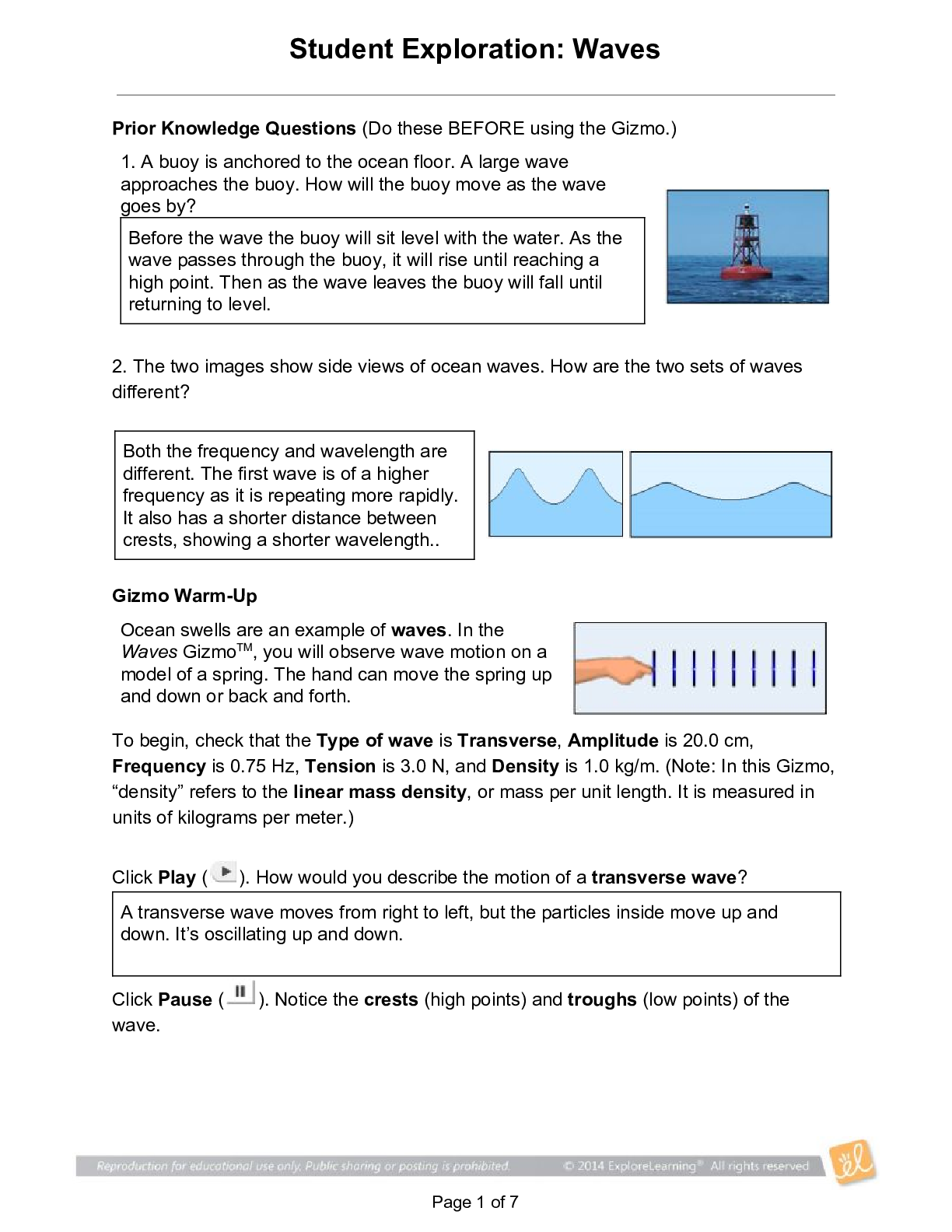
Buy this document to get the full access instantly
Instant Download Access after purchase
Buy NowInstant download
We Accept:

Reviews( 2 )

by Greg_Thornhill · 4 years ago
Welcome.. by Kirsch. 4 years ago

by Kirsch · 4 years ago
$9.50
Can't find what you want? Try our AI powered Search
Document information
Connected school, study & course
About the document
Uploaded On
Mar 27, 2021
Number of pages
7
Written in
All
Additional information
This document has been written for:
Uploaded
Mar 27, 2021
Downloads
2
Views
1069

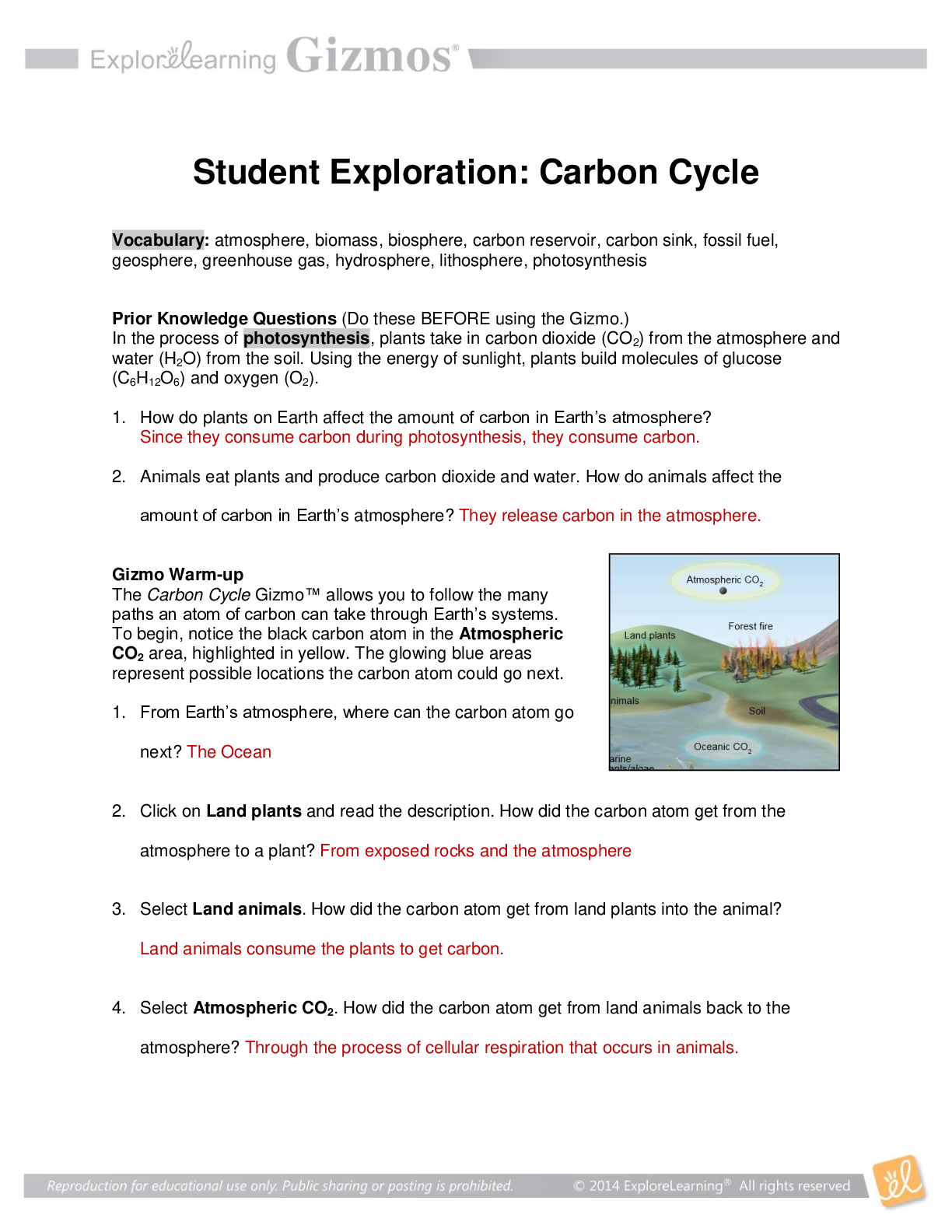
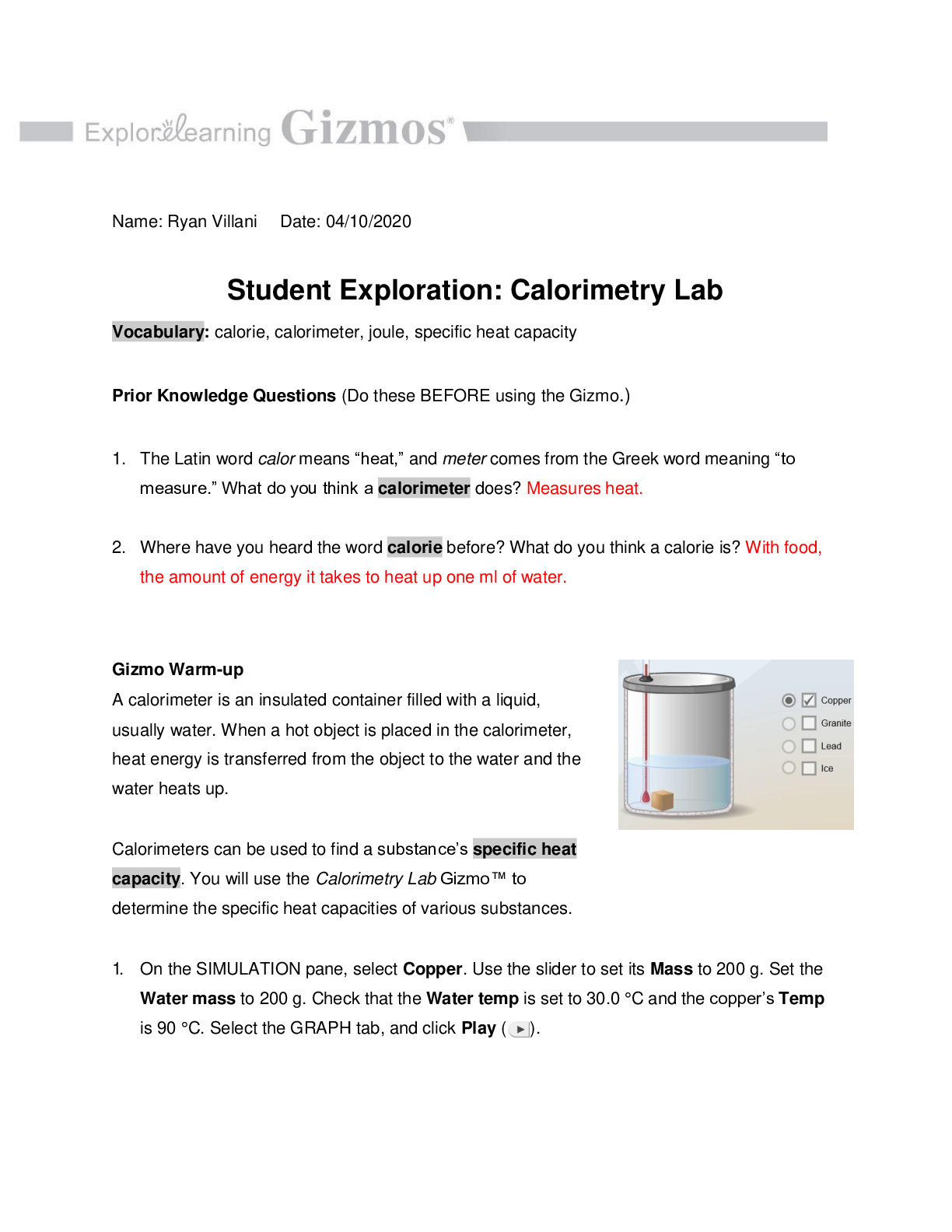
.png)
.png)



